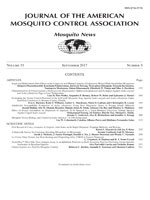La Crosse virus (LACV) is transmitted via the bites of infected Aedes mosquitoes (Ae. triseriatus, Ae. albopictus, and Ae. japonicus) and causes La Crosse encephalitis, which is the most commonly diagnosed arbovirus in eastern Tennessee children. This study identified host-seeking and oviposition activity of LACV vectors over a diel period, as it relates to traditional working hours. Nineteen sites in Knox County, TN, were monitored with host-seeking (Centers for Disease Control and Prevention [CDC] miniature light traps) and oviposition traps (CDC gravid traps) during 2 diel periods (0900–1700 h and 1700–900 h). We collected 2,444 adult mosquitoes, comprising 19 different species of which 1,337 (54.7%) were LACV vectors: Ae. albopictus (1,207 specimens), Ae. triseriatus (85 specimens), and Ae. japonicus (45 specimens). These species were active throughout the sampling period, but significantly more were collected from 1700–0900 h. The CDC gravid trap was the most effective method for monitoring Ae. japonicus; there were no trap effects or trap × time interactive effects for Ae. albopictus or Ae. triseriatus. Overall, significantly more LACV vectors were collected from 1700–0900 h compared to 0900–1700 h. Information gathered in this study improves vector surveillance, helps communities control mosquito populations, and minimizes nontarget effects.
How to translate text using browser tools
1 September 2017
La Crosse Virus Vectors Are Host-Seeking and Ovipositing After 1700 H in Eastern Tennessee
C. Urquhart,
D. Paulsen,
R. T. Trout Fryxell
ACCESS THE FULL ARTICLE
It is not available for individual sale.
This article is only available to subscribers.
It is not available for individual sale.
It is not available for individual sale.
Aedes
host-seeking
La Crosse virus
mosquito activity
oviposition





